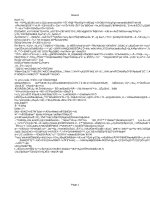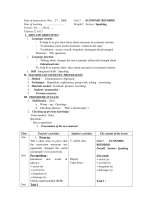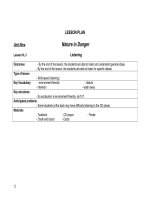Testing Listening
Bạn đang xem bản rút gọn của tài liệu. Xem và tải ngay bản đầy đủ của tài liệu tại đây (74.62 KB, 5 trang )
Testing Listening
Testing listening involves a variety of skills. At the lowest level, it involves discrimination
among sounds, discrimination among intonation and stress patterns, and comprehension of
short and long listening texts. While the first two are part of listening, they are, of course,
not sufficient.
Testing Phoneme Discrimination
Sounds are sometimes difficult to discriminate in a language other than one's native
language, especially if the sounds are not distinguished in the native language. There are
several ways to test phoneme discrimination, that is, ability to tell the difference between
different sounds. One way to test phoneme discrimination is to have the testees look at a
picture and listen to four words and decide which word is the object in the picture. The
words chosen as alternatives should be close to the correct word. However, it is often
difficult to find common enough words with similar sounds, and if unfamiliar words are
used, they will not make good alternatives. Alternatively, the testees could be presented
with four pictures and be asked to choose the picture that matches the word that they hear.
Another possibility is to give testees three words and ask them to indicate which two are
the same. Finally, testees can listen to a spoken sentence and be asked to identify which
one of four similar words were used in the sentence.
Items with full sentences have the drawback that testees can make use of not just phoneme
discrimination but also knowledge of grammar and lexical items. If one of the words that
the alternatives does not fit grammatically or semantically in the sentence, then testees who
realize that have an advantage.
This type of discrimination item is one that can be used for diagnostic purposes to see
whether students have particular problems with distinguishing between phonemes.
However, it does not give the teacher any information about the testees' ability to
comprehend spoken English.
Discriminating Stress and Intonation
The ability to recognize stress can be tested by having testees listen to a sentence that they
also have in front of them. Testees are instructed to indicate the word that carries the main
stress of the sentence. While recognizing stress patterns is useful in English, the problem
with this type of test is that it lacks a context. Testees need to show that they can recognize
the difference between "John is going today" and "John is going today," but they do not
need to show that they understand that there is a difference in the meaning of the two
sentence or what the difference is.
Ability to understand the meaning of difference in intonation can be tested by having the
testees listen to a statement and choose from three interpretations of the statement. For
example, testees might be given the statement "Vera is a wonderful musician" and be asked
to decide whether the speaker is making a straightforward statement, a sarcastic statement,
or a question. Since the context is neutral, however, it is sometimes difficult to avoid
ambiguity. In real communication, listeners make use of their background knowledge, the
context, etc., as well as the intonation to help them interpret the communicative meaning of
an utterance.
Understanding Sentences and Dialogues
A teacher can also test the students' understanding of individual sentences and dialogues. In
the simplest form, this type of item consists of a single sentence which testees listen to and
four written statements from which they choose the one closest in meaning to the original
spoken sentence. For example:
Spoken:
I had hoped to visit you while I was in New York.
Written:
A. I was in New York but did not visit you.
B. I will be in New York and hope to visit you.
C. I visited you in New York and hope to again.
D. I am in New York and would like to visit you.
Another type of item is one in which the testees listen to an utterance and choose from
among four responses the most appropriate response. In that case, the testees are not being
asked directly what the meaning of the utterance is. Rather they are being asked to show
that they know what it means by showing that they recognize an appropriate response. This
tests both the testees' listening ability and their knowledge of appropriate second pair parts
of adjacency pairs.
An example of this type of item is as follows.
Spoken: Would you mind if I visited you next time I came to New York?
Written:
A. Yes, of course. I'd love to visit New York.
B. No, I don't really think that much of New York.
C. Yes, I would. You can come any time.
D. No, not at all. I'd really love to have you.
(At a slightly higher level, both the first statement and the responses can be spoken, but in
that case, it might be better to have only three responses, since it would be difficult to keep
all four responses in mind.)
In this example, the testees need to know that "Would you mind if I..." is a form used for
asking permission, and that a positive response begins with "no (I don't mind)." Because
this type of item requires two different types of information, there is a certain amount of
controversy about it. Some theorists argue that it is not a good item type, because it
requires these two types of knowledge. Testees could possibly understand the utterance
perfectly well but not know how to respond to it. Also, since the utterances are presented in
isolation and out of context, the situation is not realistic. However, this type of item can be
useful if these limitations are kept in mind. It is a more communicative type of task than
many listening tasks, so it may have beneficial backwash effects, and it is relatively easy to
administer.
Tasks Using Visual Materials
Matching and True/False Tasks
Some types of tasks make use of visual materials along with the spoken material to test
listening. The simplest form of this task is to present testees with a picture or other visual
information (for example, a chart, graph, etc.) along with spoken true/false statements.
Testees look at the visual and decide if the statements are true or false. An alternative is to
present testees with a series of similar pictures and to have them match the pictures with
spoken sentences describing them. Similarly, the testees can listen to a short dialogue,
rather than just a statement, and decide which of the pictures matches the dialogue.
The advantage of using visual materials in this way is that they can be used to test listening
alone without involving other skills very much (if the tester considers that an advantage)--
though it is impossible to entirely eliminate the use of other skills. However, they do not
reflect the sorts of listening done in the real world.
Map Tasks
Another way to use visual materials in testing listening is to use maps. One activity
involves having testees listen to directions for how to get somewhere and follow along on
the map. They respond by drawing their route or indicating where they would be at the end
of the directions. Another possibility is to have testees listen to a conversation referring to
various locations on the map and having the testees identify the locations.
Drawing Tasks
Testees can also do drawing tasks according to instructions. For example, they can be given
a simple line drawing and be asked to complete it according to certain instructions. The
testees can be presented with a diagram of a room with the bed represented by a rectangle
and be asked to add a table, a bookcase, a door, etc., in certain locations in the room. It is
important to keep such activities simple so that the drawing task itself does not demand too
much of testees. The activity is more interesting if it can be done as part of a simple story
rather than as a list of statements, though this may depend on the level of the testees. In
addition, the students should have a chance to try out this type of activity before having to
do it as part of a test.
Tasks Involving Talks and Lectures
For students who will be using English in schools where it is the medium of instruction,
there will be situations where they need to listen to lectures or talks in English and take
notes and/or answer questions on the lecture or talk. Therefore, listening tests can involve
listening to formal or informal talks.
One way of using talks in listening tests is to have the testees listen to the talk and then fill
in the blanks in a written summary of the talk. The words chosen from blanks should be
ones that the testees cannot figure out from the context of the summary, without listening to
the talk, but they should also be ones that are related to the main idea of the talk, so that
filling in the blanks does not require remembering small details of the talk.
Another way of doing this involves giving testees questions to answer as they listen to the
talk. These questions can be short answer/completion, multiple choice, or true/false. The
difficulty with using short answer or completion questions is that they require the testees to
both read and write while they are listening, something that can be difficult even for native
speakers. Multiple choice questions may require a lot of reading, something that may also
be a problem. True/false questions may be the best type for this type of task, since they
require relatively little reading compared to multiple choice questions and relatively little
writing compared to short answer/completion questions. Also, true/false questions can also
have a "no information available" option, meaning that the information required to answer
the question is not included in the talk. This decreases the amount of guessing and reduces
the element of chance.
Another type of task that can be used is a chart that the testees fill in while listening to the
talk. Answers in some of the blanks in the chart may be filled in for the testees. Testees
should be given the chart in advance of hearing the talk, and be given time to familiarize
themselves with it and make sure they understand what is expected of them.
Finally, testees can be allowed to take notes while listening to the talk, and then use the
notes to answer questions after the talk is over. Depending on the length and complexity of
the talk, testees might be given a list of the major topics included in the talk in order to help
them in taking notes.
Summary
There are a number of ways to test listening, but, particularly when testees' listening
proficiency gets more advanced, testing listening becomes more complicated. It becomes
more difficult to separate listening from other skills, and combining skills can put great
demands on the testee. In addition, some ways of testing listening do not reflect real-world
listening tasks. In choosing tasks for listening, the teacher should be aware of these
problems.









